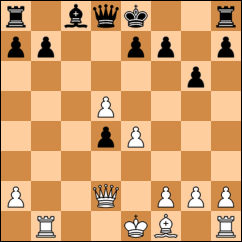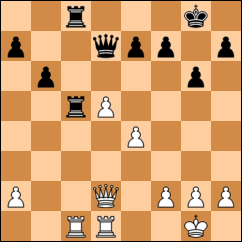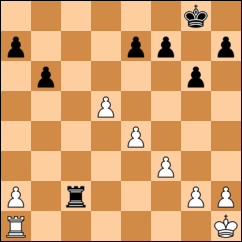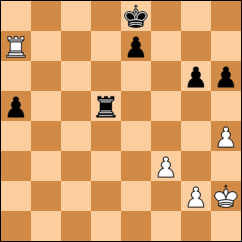Thursday 29 October 2015
White: K. Nevols - Black: A. Gillard (106)
By now you will have noticed a pattern in my games - I lose the initiative in the middle game, manage to stay on the board, and then either hang on for a draw in a lost game, or lose a drawn game. And so this continues here. My debut game in the championship of my new club - and my third consecutive game with the white pieces
1. d4 Nf6
2. c4 g6
3. Nc3 d5
Another Grunfeld defence so again we go into the exchange variation.
4. cxd5 Nxd5
5. e4 Nxc3
6. bxc3 Bg7
The theory of the system is that White sets up a centre for Black to attack with moves like c5, Nc6, Bg4. White often counters with Be3, Ne2. The method I am using I saw in an old Kasparov game of using Nf3 and Rb1.
7. Nf3 c5
8. Rb1 Nc6
Black usually castles on move 7 or 8. By playing the knight out one move early but leaving the rook on h8, I can use a tactic to get the bishops off.
9. d5!? Bxc3+
If now Ne5 I was intending Bb5+ and try to get the king castled quickly. Nxe5 Bxe5, Bb2 with Bb5+ and then f4 is another idea.
10. Bd2 Bxd2+
11. Qxd2 Nd4
The best square for the knight. If 11. Nb8 then 12. Qc3 O-O 13. Qxc5 recaptures the pawn with advantage.
12. Nxd4 cxd4

I now give some thought about what to do with the bishops and my king. With my pawns on white squares then exchanging them makes some sense, as well as diverting the Black queen away from the a5 square. The alternative could be 13. Qxd4 Qa5+ 14. Qd2 Qxd2 15. Kxd2 b6 16. Bb5+ Kd8 17. Rfc1 or 16. ... O-O 17. Bb2. Either way I get to the c-file first.
In the end I opt for the line which castles my king and brings the rook into the centre
13. Bb5+ Bd7
(The computer makes two other suggestions here - either 14. Qxd4 O-O 15. O-O Bxb5 16. Rxb5 b6 17. Rb3 to come to c3. Or simply 14. Be2).
14. Bxd7+ Qxd7
15. Qxd4 O-O
16. O-O b6
So it is queen, two rooks and six pawns each. White has the extra pawn in the centre but Black has possibilities of queenside play. Now there is a battle for the c-file.
17. Rbc1 Rac8
18. Qd2 Rc5!
I had overlooked this possibility which threatens e6. I should now play 19. Rxc5 bxc5 20. Qc2 or 20. Rc1 but I was concerned about giving Black a passed pawn.
19. Rfd1? Rfc8
Black now has the c-file and central pressure. Once again things are looking grim.

20. f3
To defend against f5 and any back rank threats.
20 . .... Qc7
21. Rxc5 Qxc5+
My rook capture was more or less forced as I did not want to see Rc2. But I was worried about bxc5. Maybe I have Qc3 with the idea of e5.
22. Kh1 Qc2
23. Qxc2 Rxc2
24. Ra1

The ending. Rook and six pawns. Black has the far more active rook so my aim must be to get space to play with and move my king up the board.
24. ... Kg7
25. h4 Kf6
26. a4 Ke5
27. Kh2 f5
An attempt to dissolve Black's centre. 27. ... e6 might have been better as now I can activate my rook and get some counterplay. 27. ... Re2 is another possibility protecting against the opening of the e-file.
28. exf5 Kxf5
If 28. ... gxf5 then 29. Re1+.
29. Re1 Kf6
30. Re6+ Kf7
31. a5
I was pleased to find this move. I had hoped to swap off my weak a-pawn and then hold up the advance of the other Black queenside pawn. If now b5 then Ra6.
31. ... bxa5
32. Ra6 Rc5
33. Rxa7 Rxd5
34. Ra6
Black has an extra pawn but I am holding on. My tactic now is to be as much of a nuisance as I can in harassing the Black king.
(The computer now suggests 34. .. Rd4 with either 35. Kg3 a4 or 35. Rxa5 Rxh4+ 36. Kg3 Rd4. However I think I would be happy with that).
34. ... Ke8
35. Ra7 h6
I was relieved to see this as it provides a weakness and an extra possibility for me to save the game.

36. g4?
As I played this I now saw 36. .. Rd2+ 37. Kg3 Ra2. Black can then happily advance his a-pawn.
36. ... Kf7?
Again relief. I don't know if Rd2+ would have won but it would have made life very difficult.
37. Kg3 g5
38. h5
Now I can target the h6 pawn but I was not sure I had enough time to take it. Fortunately my opponent offered a draw at this point which I gladly accepted.
(Interestingly, having gone though the game with an online computer, it indicates that, despite my pessimism, the game was virtually equal throughout. Neither side missed a clear winning move).
No comments:
Post a Comment